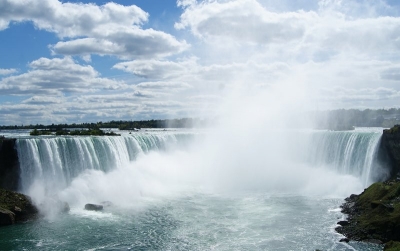
3,160 tons of water flows over Niagara Falls every second. This accounts for 75,750 gallons of water per second over the American and Bridal Veil Falls and 681,750 gallons per second over the Horseshoe Falls.
The Niagara River, and the entire Great Lakes Basin of which it is a part, is a legacy of the last Ice Age. 18,000 years ago, Southern Ontario was covered by ice sheets two to three kilometres thick. As the ice sheets advanced southward, they gouged out the basins of the Great Lakes. Then as they melted northward for the last time, they released vast quantities of melt water into these basins. Our water is “fossil water.” Less than one percent of it is renewable on an annual basis, the rest leftover from the ice sheets.
The Niagara Peninsula became free of the ice about 12,500 years ago. As the ice retreated northward, its melt waters began to flow down through what became Lake Erie, the Niagara River and Lake Ontario, down to the St. Lawrence River and on to the Atlantic Ocean. There were originally five spillways from Lake Erie to Lake Ontario. Eventually, these were reduced to one, the original Niagara Falls, at the escarpment at Queenston-Lewiston. From here, the falls began its steady erosion through the bedrock.
However, about 10,500 years ago, through an interplay of geological effects including alternating retreats and re-advances of the ice, and rebounding of the land when released from the intense pressure of the ice (isostatic rebound), this process was interrupted. The glacial melt waters were rerouted through Northern Ontario, bypassing the southern route. For the next 5,000 years, Lake Erie remained only half the size of today, the Niagara River was reduced to about 10 percent of its current flow, and a much-reduced falls stalled in the area of the Niagara Glen.
About 5,500 years ago, the melt waters were once again routed through Southern Ontario, restoring the river and falls to their full power. Then the falls reached the whirlpool.
It was a brief and violent encounter: a geological moment lasting only weeks, maybe even only days. In this moment, the falls of the youthful Niagara River intersected an old riverbed, one that had been buried and sealed during the last Ice Age. The falls turned into this buried gorge, tore out the glacial debris that filled it, and scoured the old river bottom clean. It was probably not a falls at all now but a huge, churning rapids. When it was all over, it left behind a 90-degree turn in the river we know today as the Whirlpool, and North America’s largest series of standing waves we know today as the Whirlpool Rapids.
The falls then re-established at about the area of the Whirlpool Rapids Bridge and resumed carving its way through solid rock to its present location.
Cavitation is a special type of erosion that happens at waterfalls because only at the base of waterfalls is there enough speed to produce enough bubbles close enough to rock to affect it. This is the fastest type of erosion. As the water goes over the falls, it speeds up, loses internal pressure, air escapes as bubbles or cavities. These cavities collapse when the water comes to rest, sending out shock waves to the surrounding rock, disintegrating it.
Credit : Niagara Parks
Picture Credit : Google




